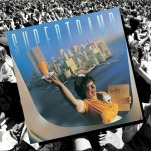Westworld has met the enemy, and it is us
Infinite Scroll is a series about the increasingly blurry lines between the internet, pop culture, and the real world.
Last week, the creators of HBO’s Westworld pranked their notoriously obsessive Reddit community, teasing a video that promised to reveal all of season two’s secrets. What they released, instead, was a 25-minute Rickroll. You’d have been forgiven for taking them at their word on it, though: The show is not exactly known for comedy. The closest it gets is the misanthropic gallows humor with which the titular park’s idiot guests are portrayed, like when an android about to deliver a rousing, newly written monologue to visitors gets brained instead by some giggling rube. These are the show’s horny, violent, monied morons, running around tittering at the wanton abuses of power they’ve paid so lavishly to enjoy. Nowhere is this clearer than in the gamer-style terminology of “white hats” and “black hats,” representing the bifurcated paths of good and bad storylines from which visitors choose. After initially visiting with his family for more wholesome attractions, like fishing and hunting for gold, one of these guests says he returned later for a solo trip. “Went straight evil,” he says. “It was the best two weeks of my life.”
The black hat-white hat binary is a joke, a reductive narrative framework that of course doesn’t exist in the real world, and that the show itself delights in subverting. There is no clear-cut “good guy” on the show, nor is there a “bad guy.” Everybody is merely a part of a broader system, whether it’s the game design behind the park itself, the corporate structure that controls it, or the various conspiracies designed to undermine both of those. Even the portentously named “Man In Black” is given an elaborate backstory as a gormless white hat who’s turned malevolent in a quest to regain his true love. It’s heavily implied that he’s only working as a catalyst of one of the park creators’ intentional design; like so many others, he’s but a cog in the bigger plan to bring about a robot revolution. This idea—that a single person has meticulously designed plot lines for each of the show’s characters—is the well from which all other theories are drawn, turning the showrunner, at last, into a divine force.
These shades of gray aren’t new to the world of prestige television, where the word “antihero” is essential to a successful pitch. What’s interesting about Westworld, specifically, is the way its first season sifts through all these dark nights of the soul and corporate-takeover plots to find, in its final moments, a pure sort of morality, one that was lying in plain sight the entire time. If there is one overarching narrative to the first season, it is the revelation of the androids Dolores and Maeve as the closest thing the show has to protagonists. Evan Rachel Wood has called the entire first season “an amazing prequel and a good setup for the actual show,” implying that what could ensue from here on out is a more clearly defined drama about good versus bad, a story of androids overthrowing their masters and the system that held them in check. In this way, it parallels that millennial classic of simulation theory, The Matrix, which similarly detailed an awakening within a larger simulation, followed by the saga of its overthrow. But Westworld has flipped The Matrix on its head: Rather than humanity reclaiming reality from its machine overlords, we’re watching machines destroy the humans who have imprisoned them in a simulation. We’re rooting for the robots.
We, it bears repeating, are humans. We typically root for ourselves in these situations. This was certainly the case in 1973’s original Westworld, as well as its 1976 sequel, Futureworld. Both of these are better and weirder movies than they get credit for, by the way, with scenes and images pulled directly into HBO’s show, like the ceremonial red surgical gowns the technicians wear and the eerie imagery of the town’s robot corpses being cleaned up by floodlight. Still, compared to the show, the androids themselves are barely considered. At their most dynamic, they are the glassy-eyed Yul Brynner who stalks the amusement park grounds like a Terminator-like death machine. But the rest are just puppets there for fucking and killing, reflective only of the visitors’ humanity—or lack thereof—and possessing none of their own. In Futureworld, a lonely old yokel engineer is friends with a dummy automaton, and he’s mostly treated as comic relief, just a weirdo living in the pipes beneath the park.
The gap between the original Westworld and its premiere on HBO is more than four decades, a period of time during which our pop culture depictions of AI evolved considerably, gradually transforming from an abstract terror to the literal embodiment of our humanity. Early examples, like 1965’s Alphaville and 1968’s 2001: A Space Odyssey, portrayed artificial intelligence as an omnipresent, almost architectural evil. Over time, the precise manner of that evil changed to reflect new anxieties: The Terminator portrayed the inevitable AI takeover as a boots-on-the-ground invasion of our homeland, full of skull-mulching tanks and machine guns. WarGames treated it as the dispassionate, sentient manifestation of Cold War paranoia.





















![Rob Reiner's son booked for murder amid homicide investigation [Updated]](https://img.pastemagazine.com/wp-content/avuploads/2025/12/15131025/MixCollage-15-Dec-2025-01-10-PM-9121.jpg)


















